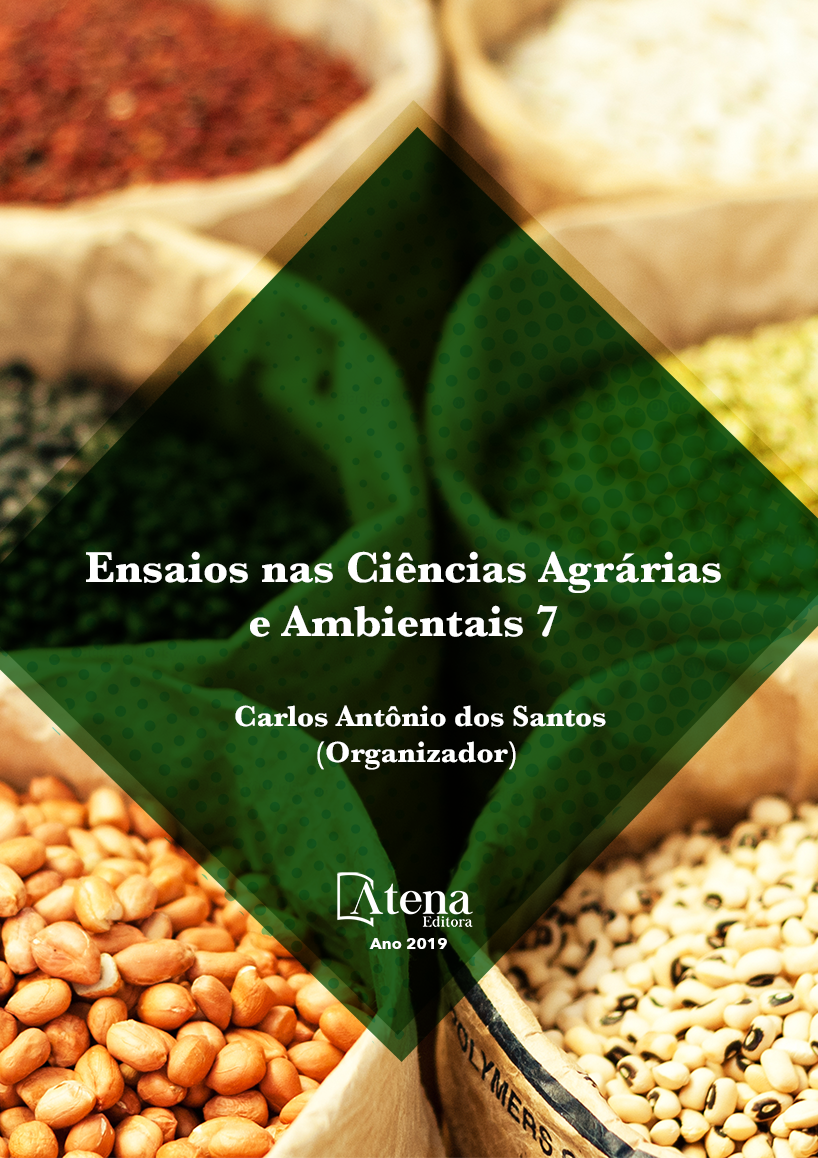
MACROFAUNA EDÁFICA EM SISTEMAS DE MANEJO DO SOLO COM UTILIZAÇÃO DE ADUBAÇÃO BIOLÓGICA E BIOESTIMULANTE
O presente estudo objetivou avaliar o
comportamento da fauna edáfica em diferentes
sistemas de manejo do solo com cultivo de
milho (Zea mays L.), submetido à adubação
biológica e bioestimulantes. O experimento foi
conduzido em delineamento experimental de
blocos casualizados em parcelas subdivididas,
em esquema fatorial 3x4. Os tratamentos foram
constituídos pela interação do fator 1 (sistemas
de manejo): realização da escarificação da área
antes da semeadura a dois anos consecutivos
(ESC), escarificação da área e posterior retorno
a semeadura direta a dois anos (ESD), e
semeadura direta com mais de 10 anos (SD),
e fator 2 (adubações biológicas): Bacsol® 200g
ha-1 (BAC); Orgasol® 200ml ha-1 (ORG); Mistura
de Bacsol® 200g ha-1 + Orgasol® 200ml ha-1 (M).
O tratamento testemunha foi caracterizado pela
não utilização da adubação biológica (TEST).
Três meses após a instalação do experimento foi
realizada a coleta dos organismos da fauna do
solo por meio da instalação de três armadilhas
do tipo “Trampas de Tretzel” distribuídas ao
acaso em cada parcela [n = 60 parcelas x 3
armadilhas por parcela = 180]. As variáveis
analisadas foram: Indivíduos por armadilha (Ind.
arm-1), e índices de diversidade de Shannon
(H’), Dominância (D) e uniformidade de Pielou
(J). Os dados obtidos foram submetidos à
análise de variância (ANOVA). Avaliou-se ainda
a frequência relativa (FR), dissimilaridade e
similaridade através de análises ANOSIM e
SIMPER, escalonamento multidimensional não
métrico (Non-metric Multidimentional Scalling
- NMDS) e análise de redundância (AR). As
variáveis analisadas apresentaram diferenças
apenas em relação aos sistemas de manejo. O
sistema SD apresentou os melhores resultados
para o Ind. arm-1. A ordem Hymenoptera representou mais de 40% da ocorrência
total, em todos os tratamentos estudados. As análises multivariadas evidenciaram a
separação dos sistemas SD e ESD de ESC. A AR evidenciou o efeito dos atributos
químicos (cálcio, pH e alumínio) e físicos (densidade de partícula) sobre alguns grupos
da macrofauna edáfica. O uso da adubação biológica em sistemas de cultivo de milho
não afetou a composição da comunidade edáfica. Já os sistemas de manejo do solo
afetaram a fauna edáfica, demonstrando o rápido reestabelecimento da mesma um
ano após o retorno a semeadura direta no tratamento ESD.
MACROFAUNA EDÁFICA EM SISTEMAS DE MANEJO DO SOLO COM UTILIZAÇÃO DE ADUBAÇÃO BIOLÓGICA E BIOESTIMULANTE
-
DOI: 10.22533/at.ed.5031927024
-
Palavras-chave: Sistemas conservacionistas, invertebrados do solo, sustentabilidade.
-
Keywords: Conservation systems, soil invertebrates, sustainability.
-
Abstract:
The present study aimed to evaluate the behavior of soil fauna in different
soil management systems with maize (Zea mays L.) cultivation, submitted to biological
fertilization and biostimulants. The experiment was conducted in a randomized
complete block design in subdivided plots, in a 3x4 factorial scheme. The treatments
were constituted by the interaction of factor 1 (management systems): scarification of
the area before sowing to two consecutive years (ESC), scarification of the area and
subsequent return to two-year direct seeding (ESD), and direct seeding with more than
10 years (SD), and factor 2 (biological fertilizations): Bacsol® 200g ha-1 (BAC); Orgasol®
200ml ha-1 (ORG); Mixture of Bacsol® 200g ha-1 + Orgasol® 200ml ha-1 (M). The control
treatment was characterized by the non-use of biological fertilization (TEST). Three
months after the installation of the experiment the soil fauna organisms were collected
by means of the installation of three traps of the type “Tretzel Traps” distributed randomly
in each plot [n = 60 plots x 3 traps per plot = 180]. The variables analyzed were:
individuals per trap (Ind. arm-1), and indices of diversity of Shannon (H ‘), Dominance
(D) and uniformity of Pielou (J). The data were submitted to analysis of variance
(ANOVA). It was also evaluated the relative frequency (FR), dissimilarity and similarity
through ANOSIM and SIMPER analysis, non-metric multidimensional scaling (NMDS)
and redundancy analysis (RDA). The analyzed variables presented differences only in
relation to the management systems. The SD system presented the best results for the
Ind. arm-1. The order Hymenoptera represented more than 40% of the total occurrence,
in all treatments studied. The multivariate analysis showed the separation of the SD
and ESD systems from ESC. RDA evidenced the effect of chemical attributes (calcium,
pH and aluminum) and physical (particle density) attributes on some groups of edaphic
macrofauna. The use of biological fertilization in maize cropping systems did not affect
the composition of the soil community. On the other hand, the soil management systems
affected the soil fauna, demonstrating the rapid reestablishment of the same one year
after the return to direct sowing in the ESD treatment.
-
Número de páginas: 15
- Elston Kraft
- Daniela Cristina Ramos
- Edpool Rocha Silva
- Dilmar Baretta
- Carolina Riviera Duarte Maluche Baretta


